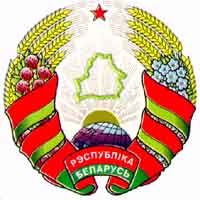Republik Belarus (Respublika Belarus)
- Lage
- Im Westen des osteuropäischen Flachlandes zwischen der Ukraine, Polen, Russland und den baltischen Staaten im Einzugsgebiet von Memel, Düna, mittlerem Dnjepr.
- Fläche
- gesamt: 207 600 qkm
- Land
- 207 600 qkm
- Wasser
- keine Meeresküste
- Landesgrenzen
- gesamt: 3 098 km
- Grenzstaaten
- Polen 605 km, Russland 959 km, Ukraine 891 km, Litauen 502, Lettland 141 km
|
Daten des Statistischen Bundesamtes |
|||
| Bevölkerung | 10,1 | Mill. | 2001 |
| Fläche | 207595 | qkm | 2001 |
| Bevölkerungsdichte | 49 | Einw. je qkm | 2001 |
| Arbeitslosenquote | 2,1 | % | 2000 |
| Bruttoinlandsprodukt (BIP) | 29950 | Mill.US-$ | 2000 |
| Jährliches BIP-Wachstum (real) | 5,8 | % | 2000 |
| BIP je Einwohner (real) | 2760 | US-$ | 2000 |
| Inflationsrate | 168,6 | % | 2000 |
| Importe | 8492 | Mill.US-$ | 2000 |
| Exporte | 7331 | Mill.US-$ | 2000 |
| Saldo der Im- und Exporte | -1161 | Mill.US-$ | 2000 |
| PKW-Dichte | 142 | je 1000 Einw. | 2000 |
| Personal-Computer | n.v. | ||
- Hauptstadt
- Minsk (1 700 000 EW)
- Städte
- Minsk (1,7 Mio. EW), Gomel (600 000 EW), Mogilew (370 000 EW), Witebesk (350 000 EW), Grodno (300 000 EW), Brest (300 000 EW), Bobruisk (224 000 EW), Baranovitchi (171 000 EW), Orscha (140 000 EW), Pinsk (128 000 EW), Mozyr (104 000 EW)
- Staatsform
- Präsidiale Republik, seit 1991 unabhängiger Teilstaat der GUS.
- Verwaltungsstruktur
- Sechs Gebiete (Oblast): Minsk, Gomel, Mogilew, Witebesk, Grodno und Brest diese unterteilt in Kreise (Rayon)
- Klima
- Maritim-kontinentales Übergangsklima mit kalten Wintern (Januarmittel -5 bis -7 °C)
- Landschaft
- Mischwälder mit Birken, Eichen, Ahorn und Fichten bedecken ein Drittel der Fläche. Der Dnjepr und andere große Flüsse durchfließen das überwiegend flachwellige Land mit sandigen Ablagerungen aus der vorletzten Eiszeit. Im Süden liegt das große Sumpfgebiet Poljessje.





